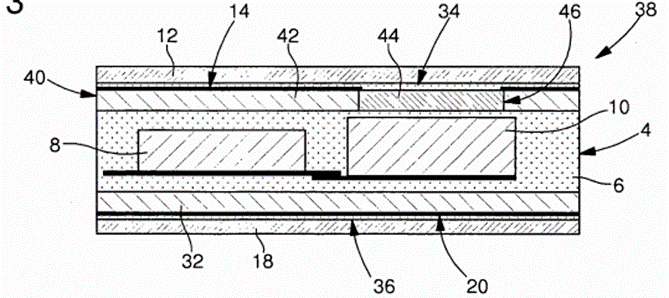The patent relates to a card with a digital display (10) comprising inter alia a “transparent” insert (44) as well as an “opaque” plastic layer (40) recovering the remainder of the card.

The present post is part of a series of three posts dealing with different aspects in opposition.
Brief outline of the case
Both opponents appealed the decision of maintenance in amended form according to a MR. Opponent 2 later withdrew its appeal.
Opponent 1 considered that the MR was not in conformity with R 80.
Opponent 1 also elaborated on the objection raised during the opposition against the amendments to claim 1 and relating to the clarity of the claims.
Opponent 1 also contended that the requirements of Art 83 and 123(2) as well as Art 54 and 56 were not fulfilled.
In reply to the board’s communication under Art 15(1) RPBA20 the proprietor filed a new MR.
Opponent 1 considered that the new MR should not be admitted. They also represented an amendment of the proprietor’s case which is not admissible at a late stage of the appeal procedure.
The board considered that the claims filed in reply to its communication were admissible and allowable.
The board decided remittal to the OD with the order to maintain the patent on the basis of the last MR completed by a description and the figures to be adapted, if necessary.
In the present post we will deal with the clarity objections.
The clarity objection
The opponent’s position
The amendments to claim 1 resulted, in his view, to lack of clarity of the independent claims relating an intermediate product (claim 5), the manufacture of such intermediate product (claim 7) and the batch manufacture of electronic boards (claim 11), as these did not reproduce the features introduced in independent claim 1.
The board’s position
While it is accepted that an amendment to one independent claim may affect the understanding of other independent claims, this can only result from an actual relationship between such claims.
In the present case, independent claims 5 and 7 contain no reference to amended claim 1, while independent claim 6 refers exclusively to independent claim 5.
For these reasons, the arguments put forward by Opponent 1 that the clarification of claim 1 as to the presence of a specific feature, would lead to difficulties in the interpretation of independent claims 5, 6 and 7 are not convincing. Contrary to Opponent 1’s view, the absence of the feature in question in those claims does not affect their interpretation.
The further amendments to independent claims 1, 5, 6 and 7 as to the opaque nature of the material constituting the plastic sheet comply with the clarity requirements of Art 84.
Even if the adjective “opaque“, like the adjective “transparent“, has only a relative meaning, the context of the invention nevertheless makes it possible to specify its boundaries.
“Opaque” implies that, under normal conditions of use the material selected is such that it absorbs a large proportion of the radiation emitted in the visible range of the electromagnetic spectrum.
Comments
The present decision makes clear that in case of a plurality of independent claims it is only if other independent claims refer directly to the amended claim that clarity of the claims as whole can be affected.
It is also a good reminder that relative terms can be perfectly clear in the context.
https://www.epo.org/law-practice/case-law-appeals/recent/t170273fu1.html
Comments
Leave a comment